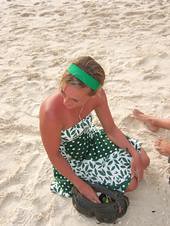Reef Rescue :Coral Nursery (Phi Phi Ley)
I have written previously on the subject of the coral nursery located by Table Coral City on Phi Phi Ley, a joint research project and initiative headed up by the PMBC (Phuket Marine Biological Center) and Andrew Hewwitt (The Adventure Club).
Background: The concept behind this nursery is the use of forestation techniques to remove small coral fragments from donor colonies and suspend them on nursey racks above the substrate aiding reproduction and monitored growth with a reduced threat from corallivoes (e.g. parrotfish, crown of thorns etc.) Once these fragments reach an appropriate size they are then transplanted out onto the surrounding reefs (as in December 2007 archives).

Unfortunately this month around the 13th June, it was noticed by our divemaster Ya that the nursery had sustained some unspecified damage so Jon and I set out to investigate and ascertain what the damage was and if there were any temporary measures we could instigate until such time as Andrew Hewwitt or Doctor Nalinee from the PMBC could come over. There are 2 nursery racks, each approximately 2 metres by 10 metres, suspended by ropes screwed in to the sea floor and bouyed up by inner tubing and bouys under each palette. These ordinarily then lay horizontally at around 8 meters underwater (so at a 90 degree angle).
Somewhat laiden down with an extra tank and reg. set, a liftbag, rope, some mooring buoys, hammers, and all gloved up we arrived to what you see below. The northern rack instead of looking like this "-" vaguely resembled an "s" on its side. One end remained as it should be but the other was hanging down to the sea bottom. The Southern rack had flipped towards one side so was at a 180 degree angle.








It took us approx. 35 minutes to analyse what the problems were, and it appeared that one rope had gone, another was completely entangled and that there was insufficient uplift or buoying left. We hammered away at some of the molluscs which had attached themselves to the buoys and tubing under the rack and worked our way carefully amongst the ropes and lines to dis-entangle them which added some lift to the northern rack. The southern rack required a little more planning and work, so we attached a lift bag to the central rope on one side of the rack and started to inflate until we arrived at the desired angle. We then tied a new length of rope (which happened to be climbing rope...just as a temp. fix!) between this rack, a sea screw and the other rack in a V shape.


We added a few extra small buoys to this rack on what had been the fallen side and released the air from the lift bag...all was temporarily at least as it should be again thankfully!!!






I am pleased to report that last week Andrew and some members of the Greenfins organisation managed to spend the day on the nursery, and have fully replaced all the ropes and removed more molluscs so that all is better than new:)







